|
|||||
|
|||||||
|
    An initiative of :Stichting Food-Info
|
| Food-Info.net> Products > Pasta The industrial production of pastaA quality pasta product begins with high quality raw material. Durum wheat is ideally suited for pasta because of its unique colour, flavour and cooking qualities. 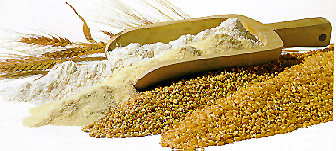 Incoming wheat is weighed, sampled and analyzed, passed through a preliminary cleaner and magnet, then stored according to grade. Meticulous cleaning is required for durum wheat. Cleaners remove weed seeds, dirt and other extraneous material through machines which separate by size (separator), specific gravity (de-stoner and gravity table), and shape (indented cylinder). Frictional cleaning equipment (scourers) scours the surface of the kernel, removing the outermost layers of the bran. The next step is tempering the grains. During tempering, water is added to toughen the outer bran coats for easier separation from the endosperm. Tempering also mellows the endosperm for grinding. Traditionally, durum wheat is tempered for a relatively short time. However, new technology in pasta manufacturing now enables finer semolina to be used, allowing for longer tempering periods. MillingMilling is essentially a process of grinding and separating. Grinding is done on break rolls, sizing rolls and reduction rolls. Separation is done using machines called sifters and purifiers. A durum mill has an extended break system in which grinding is relatively gradual. The endosperm is released in coarse granular form rather than as flour. The grading, purifying and sizing systems are more extensive in a durum mill, but the reduction system is very small compared to that of a flour mill. SemolinaSemolina, the main product of durum milling, is coarser than the flour produced in common wheat milling. Desirable characteristics for semolina include good colour, minimum dark or bran specks and uniform granulation. Small amounts of fine semolina and flour are produced. These are often combined with normal semolina to produce blended material which can be used for a wide range of long and short pasta types. 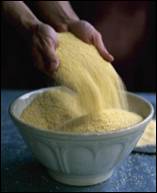 Semolina (Source) PastaTo make the pasta, semolina is mixed with water (and eggs is required) to form a lumpy dough. The dough is not fully developed until it passes from the mixing chamber into the extruder.
Dough is forced through various shaped dies (see below), under very high pressures, to produce a wide range of different shapes of pasta products. The extrusion chamber is designed to draw off heat generated by the pressure and friction created during the extrusion process. To prevent the pasta from sticking together in the drying process, long pasta is subject to a blast of air immediately after extrusion. Short pasta is transferred to a shaking pre-dryer to ensure it is separated. DryingDrying is a crucial part of the process for production of high quality pasta products. Humidity, air flow and temperature are carefully controlled as the pasta passes through several dryers. Modern high temperature drying systems improve pasta colour and cooking quality. In the final stage of drying, cooling chambers return the dried pasta to normal atmosphere conditions. In general, the product is dried to a moisture level of about 12 per cent. The total drying time can take from six to 24 hours depending on the drying technology used. PackagingFollowing drying, the pasta is cooled, stored, cut and then packed.
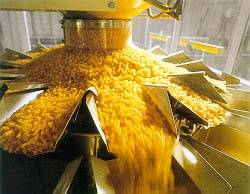 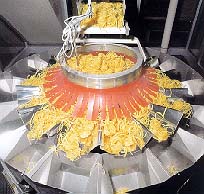 Pasta packaging The shapesAn extremely important feature of pasta is the richness and variety of its shapes. Even though all pasta is produced with the same raw materials, each shape, in a certain sense, has its own personality: as regards, for instance, the type of sauce that best goes with it; or the way of using it, with meat or vegetable stock, or drained and served with sauces of every kind. Pasta shapes stimulate culinary creativity because they are themselves the outcome of a creative process. The countless shapes of pasta are the basis for thousands of possible recipes, each one different and characteristic. And this distinctive element of pasta is mainly created by just one object: the die.
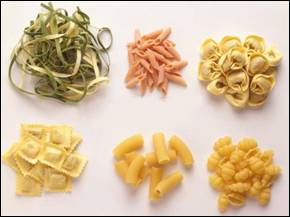 Some examples of pasta shapes A die is a basic component of a press: the dough, formed in the kneading tank and then driven by the extrusion screw towards the head of the press, is forced through the die. A die is composed of a main support, normally made of bronze. This support is drilled with special techniques and each hole is made to house a drawing insert. The shape and type of insert determines the final shape of the pasta. The dough is pressed through the insert, which provides the basic structure of the pasta (tube, hollow, sprial). Behind the die there is often an additional structure that bends, folds or cuts the pasta to form the final shape. The classic material for the insert is bronze, which is still entirely used to make traditional dies. Dies made entirely of bronze have the feature of giving the surface of the pasta a minutely jagged and porous appearance, with highlights making it look white: this is a direct consequence of the nature of the material used for the die since the surface of bronze is never perfectly smooth. Click here for an overview of pasta shapes.
|
|
| ||
| Food-Info.net is an initiative of Stichting Food-Info, The Netherlands | ||||||